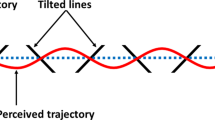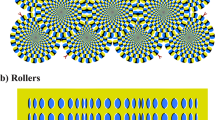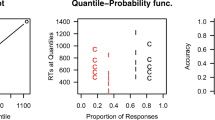Abstract
In vision, the discovery of the phenomenon of saccadic suppression of displacement has made important contributions to the understanding of the stable world problem. Here, we report a similar phenomenon in the tactile modality. When scanning a single Braille dot with two fingers of the same hand, participants were asked to decide whether the dot was stationary or whether it was displaced from one location to another. The stimulus was produced by refreshable Braille devices that have dots that can be swiftly raised and recessed. In some conditions, the dot was stationary. In others, a displacement was created by monitoring the participant’s finger position and by switching the dot activation when it was not touched by either finger. The dot displacement was of either 2.5 mm or 5 mm. We found that in certain cases, displaced dots were felt to be stationary. If the displacement was orthogonal to the finger movements, tactile suppression occurred effectively when it was of 2.5 mm, but when the displacement was of 5 mm, the participants easily detected it. If the displacement was medial–lateral, the suppression effect occurred as well, but less often when the apparent movement of the dot opposed the movement of the finger. In such cases, the stimulus appeared sooner than when the brain could predict it from finger movement, supporting a predictive rather than a postdictive differential processing hypothesis.




Similar content being viewed by others
References
Bays PM, Husain M (2007) Spatial remapping of the visual world across saccades. Neuroreport 18(12):1207–1213
Bays PM, Wolpert DM, Flanagan JR (2006a) Perception of the consequences of self-action is temporally tuned and event driven. Curr Biol 15:1125–1128
Bays PM, Flanagan JR, Wolpert DM (2006b) Attenuation of self-generated tactile sensations is predictive, not postdictive. PLoS Biol 4(2):e28
Bridgeman B, Stark L (1991) Ocular proprioception and efference copy in registering visual direction. Vis Res 31:1903–1913
Bridgeman B, Hendry D, Stark L (1975) Failure to detect displacement of visual world during saccadic eye movements. Vis Res 15:719–722
Chapman CE (1994) Active versus passive touch: factors influencing the transmission of somatosensory signals to primary somatosensory cortex. Can J Physiol Pharmacol 72:558–570
Chapman CE, Beauchamp E (2006) Differential controls over tactile detection in humans by motor commands and peripheral reafference. J Neurophysiol 96:1664–1675
Craig JC (1999) Grating orientation as a measure of tactile spatial acuity. Somatosens Mot Res 16:197–206
Cullen KE (2004) Sensory signals during active versus passive movement. Curr Opin Neurobiol 14:698–706
Deubel H, Schneider WX, Bridgeman B (2004) Different effects of eyelid blinking and target blanking on saccadic suppression of displacement. Perception & Psychophysics 66:772–778
Dodge R (1900) Visual perception during eye movement. Psychol Rev 7:454–465
Dyhre-Poulson P (1978) Perception of tactile stimuli before ballistic and during tracking movements. In: Gordon G (ed) Active touch. Pergamon Press, Oxford, pp 171–176
Fitzgerald PJ, Lane JW, Thakur PH, Hsiao SS (2006) Receptive field properties of the macaque second somatosensory cortex: representation of orientation on different finger pads. J Neurosci 26:6473–6484
Gallace A, Auvray M, Tan HZ, Spence C (2006) When visual transients impair tactile change detection: a novel case of crossmodal change blindness? Neurosci Lett 398:280–285
Ghez C, Lenzi GL (1971) Modulation of sensory transmission in cat lemniscal system during voluntary movements. Pflügers Archiv European Journal of Physiology 323:273–278
Haarmeier T, Thier P (1996) Modification of the Filehne illusion by conditioning visual stimuli. Vis Res 36:741–750
Haggard P (2006) Sensory neuroscience: from skin to object in the somatosensory cortex. Curr Biol 16:884–886
Hatwell Y (1986) Toucher l’espace. La main et la perception tactile de l’espace. Presses Universitaires de Lille, Lille
Heller MA (1986) Active and passive tactile braille recognition. Bulletin of the Psychonomic Society 24:201–202
Johnson KO, Phillips JR (1981) Tactile spatial resolution. I. Two-point discrimination, gap detection, grating resolution, and letter recognition. J Neurophysiol 46:1177–1191
Loomis JM (1985) Tactile recognition of raised characters: A parametric study. Bulletin of the Psychonomic Society 23:18–20
Matin E (1974) Saccadic suppression: A review and an analysis. Psychol Bull 81:899–917
Millar S (1997) Reading by Touch. Routledge, London
O’Regan JK, Noë A (2001) A sensorimotor account of vision and visual consciousness. Behavioral and Brain Sciences 24:883–917
Poincaré H (1908) Science et Méthode. Flammarion, Paris
Rensink RA, O’Regan JK, Clark JJ (1997) To see or not to see: the need for attention to perceive changes in scenes. Psychological Science 8(5):368–373
Ross J, Morrone MC, Burr DC (1997) Compression of visual space before saccades. Nature 386:587–601
Stevenson SB, Volkmann FC, Kelly JP, Riggs LA (1986) Dependence of visual suppression on the amplitudes of saccades and blinks. Vis Res 26:1815–1824
Taylor-Clarke M, Jacobsen P, Haggard P (2004) Keeping the world a constant size: object constancy in human touch. Nat Neurosci 7:219–220
Vitello MP, Ernst MO, Fritschi, M (2006) An instance of tactile suppression: Active exploration impairs tactile sensitivity for the direction of lateral movement. Proceedings of EuroHaptics 2006, pp 351–355
Vitevitch MS (2003) Change deafness: the inability to detect changes between two voices. Journal of Experimental Psychology: Human Perception Performance 29:333–342
Volkmann FC, Riggs LA, Moore RK (1980) Eyeblinks and visual suppression. Science 207:900–902
Wallach H, Lewis C (1966) The effect of abnormal displacement of the retinal image during eye movements. Perception & Psychophysics 1:25–29
Weale RA (1966) Why does the human retina possess a fovea? Nature 212:255–256
Wertheim AH (1994) Motion perception during self-motion: The direct versus inferential controversy revisited. Behavioral and Brain Sciences: 17:293–355
Wexler M, Panerai F, Lamouret I, Droulez J (2001) Self-motion and the perception of stationary objects. Nature 409:85–88
Williams SR, Chapman CE (2000) time course and magnitude of movement-related gating of tactile detection in humans. II. Effect effects of stimulus intensity. J Neurophysiol 84:863–875
Williams SR, Chapman CE (2002) Time course and magnitude of movement-related gating of tactile detection in humans. III. Effect of motor tasks. J Neurophysiol 88:1968–1979
Williams SR, Shenesa J, Chapman CE (1998) Time course and magnitude of movement-related gating of tactile detection in humans. I. Importance of stimulus location. J Neurophysiol 79:947–963
Acknowledgments
Special thanks to Dominique Aubert for help with the software. This research was supported by a Special Research Opportunity Grant from the Natural Sciences and Engineering Research Council of Canada (NSERC).
Author information
Authors and Affiliations
Corresponding author
Rights and permissions
About this article
Cite this article
Ziat, M., Hayward, V., Chapman, C.E. et al. Tactile suppression of displacement. Exp Brain Res 206, 299–310 (2010). https://doi.org/10.1007/s00221-010-2407-z
Received:
Accepted:
Published:
Issue Date:
DOI: https://doi.org/10.1007/s00221-010-2407-z




